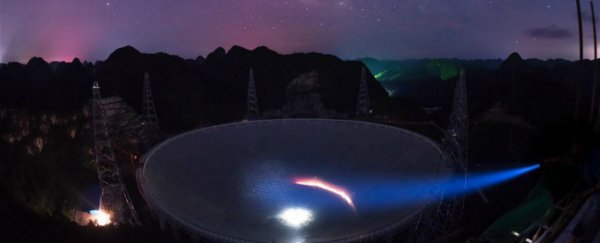China just finished installing the last piece in the world's largest single-dish radio telescope, which stretches the size of 30 soccer fields on the side of a mountain in the south-western province of Guizhou.
The 500-metre Aperture Spherical Telescope, or FAST for short, will be used to explore some of the most mysterious objects in the Universe, such as black holes and pulsars, and will "search for intelligent life from outer space", according to China's state broadcaster CCTV.
The US$185 million telescope will be able to detect radio waves coming from space in more detail than ever before, and will let us peer back in time to into the web of hydrogen gas that existed before galaxies formed in the early Universe.
"FAST will enable Chinese astronomers to jump-start many scientific goals, such as surveying the neutral hydrogen in the Milky Way, detecting faint pulsars, and listening to possible signals from other civilisations," said Nan Rendong, general engineer and chief scientist on the FAST project. "It's time for China to have its own big telescope."
The telescope is built into a natural depression, which protects the device from electromagnetic interference and allows its powerful receiver, which was designed with the help of Australian scientists, to hone in on signals in space.
With 4,450 reflective panels, the telescope is constructed with a similar design to the previous largest radio telescope, the Arecibo Observatory in Puerto Rico, but it's a lot bigger - Arecibo is only 305 metres in diameter.
It'll now undergo months of debugging before it's estimated to officially begin operations in September, according to the Chinese Academy of Sciences, who oversaw the project with the National Astronomical Observatories.
Once it's live, it'll be looking for short bursts of radio waves known as pulsars, which are rotating neutron stars that emit a beam of electromagnetic radiation that we can only detect when it's pointing towards Earth.
Not only are these stars fascinating in their own right, but they can also be used like very accurate timekeepers to help us measure any other forces in the Universe, such as the effects of gravitational waves rippling out from the Big Bang.
"Understanding the fundamental physics of pulsars will help us understand the Big Bang," Yue Youling, associate researcher with the National Astronomical Observatories, told CCTV, as Time magazine reports. "Now we only know what happened after the Big Bang, everything before that relies on our calculation. Therefore, there are a lot of uncertainties."
There's no official word as yet on what the extraterrestrial hunt will involve, but a good place to start might be Tabby's star and its strange orbiting megastructure?
This isn't China's only big investment in science and technology recently. Last month, they unveiled the world's first 93-petaFLOP computer - built mainly from local technology.
They've also announced they'll be putting a man on the moon by the 2030s, and have started building their own space station.
We're pretty excited to see what scientists both in China around the world can do with the data collected by FAST. Fingers crossed for aliens.
